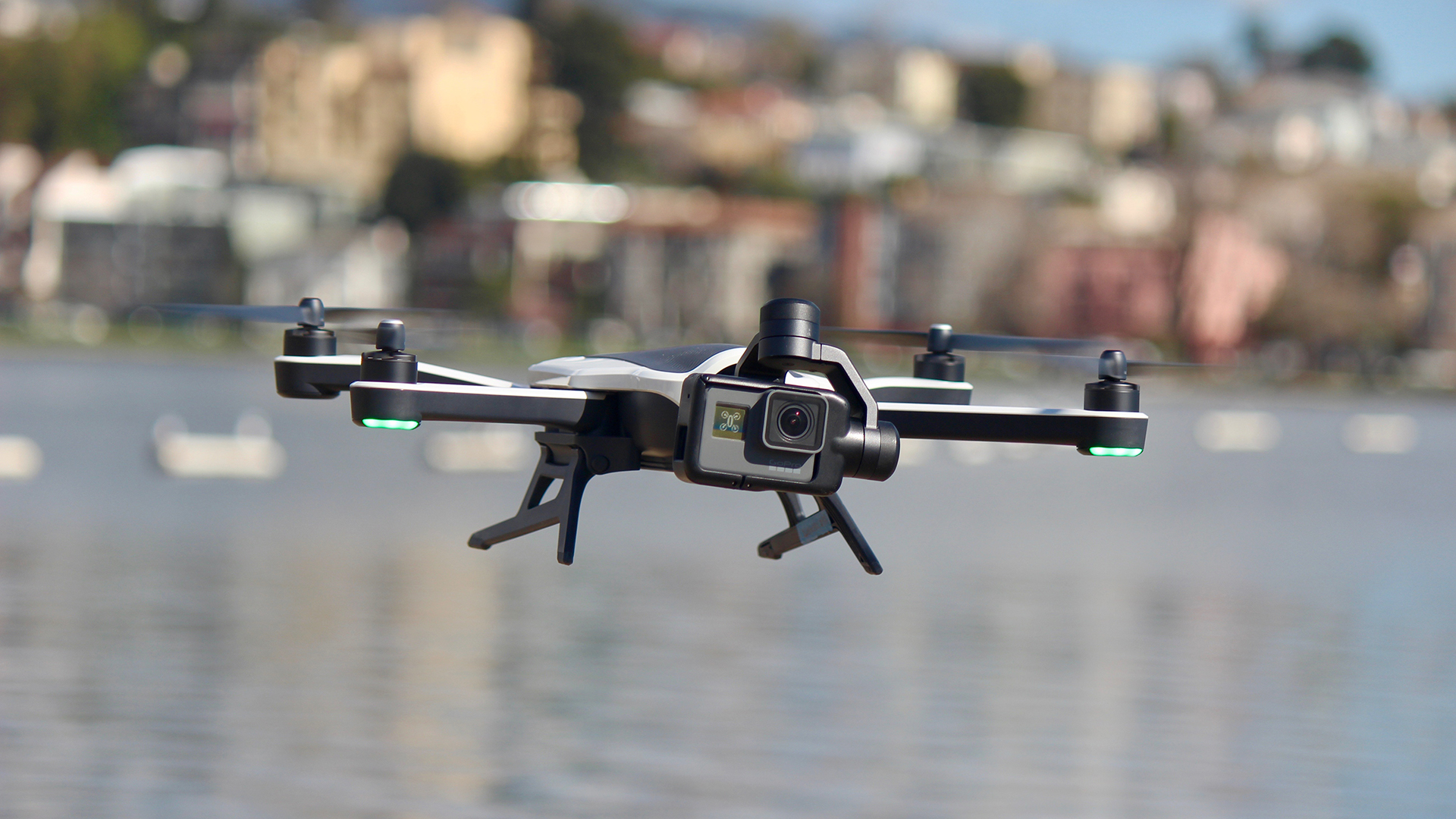The Karma Drone has been GoPro’s soap opera. It’s been a rollercoaster of excitement and disappointment, all of which started with vague sightings and rumors leading up its grand arrival – and the long-awaited drone was then recalled a few months later, when a fatal battery flaw began causing drones to lose power mid-flight and fall from the sky.
GoPro has now addressed the Karma Drone’s battery woes and put it back on sale. But, the question is, has the world of drones moved on in its absence, and is there still room for the Karma?
Price and availability
Drones aren't cheap, but the GoPro Karma comes in at a surprisingly reasonable $ 1,099 (£999, AU$ 1,649) price considering everything that's included in the package.
That price puts it just slightly above the $ 999 (£1,099, AU$ 1,699) DJI Mavic Pro and $ 799 (£829, AU$ 1,899) Yuneec Q500 4K Typhoon; but, as the line goes, the Karma is so much more than a drone. The GoPro package offers more versatility, with a removable GoPro Hero5 camera that you can use separately or attach to a handheld gimbal.
There are also plenty of barebones options to purchase only what you need. The Karma Drone is especially tantalizing for GoPro Hero 5 owners, as the rest of the package costs $ 799 (£719, AU$ 1,195) without the bundled camera.
There are even more slimmed-down options. There’s a drone-only kit for $ 599 (about £470, AU$ 790), while $ 399 (about £320, AU$ 530) nets you just the quadcopter without a gimbal or even the included controller.
Users can also purchase the Karma Grip on its own for $ 299 (£289, AU$ 499), while for those who are curious the GoPro Hero 5 costs $ 399 (£399, AU$ 549).
At the time of writing, GoPro has only announced that the Karma Drone is back on sale in the US. However, we expect availability at its original pricing (as we’ve listed) should be returning to other territories including the UK and Australia.

Design
The Karma Drone led the charge for compact quads when it debuted last September. Measuring 14.4 x 8.8 x 3.5 inches (36.5 x 22.4 x 9cm) when all folded up, it's dramatically smaller than the DJI Phantoms that have dominated the consumer airspace for years.
However, this is exactly where DJI came in to steal the Karma’s thunder with the water bottle-sized Mavic Pro, which was announced a week after GoPro’s quad.
Despite it not being the smallest drone in the world, the way you can stash the Karma into a regular backpack is admirable. This is all thanks to a folding design that sees the both sets of arms flipping forward, while the landing gear closes flat against the drone’s underside.

The Karma Drone is also unique in that the camera sits on its nose, whereas most quads have the camera hanging underneath their fuselages. Seating the camera up front enables a greater range of upward movement. Another benefit is that the rotors and the drone’s chassis are rarely captured on video.
The Karma Drone’s greatest asset is its versatility
Unlike other drones, the camera and even the stabilizing gimbal aren’t permanently attached to the Karma Drone. You can pull out both the camera and gimbal after giving the front collar lock a quick twist, and attach it to the included Karma Grip for stabilized handheld video.
Alternatively, the camera is held in place by a simple clamp that you push to open. Once it's removed you’ll have a standard GoPro Hero 5 camera that you can use for your earthbound action shots.
Last but not least, the included controller also makes the Karma Drone stand out. It comes with an integrated 5-inch touchscreen, along with all the usual flight controls, and folds up into a portable package just like the drone itself.

Build and handling
Although the Karma Drone's main body is made primarily of a lightweight plastic, it feels tougher and sturdier than most quads. During our month with the drone, it survived several scuffs along the ground and hard landings unscathed.
In the event of a real crash, it’s easy enough to replace parts. You can take out the metal limbs with a single screwdriver; meanwhile, the gimbal assembly also makes replacing the camera and its stabilizer a simple process.
Unfortunately, the Karma Drone isn’t as sturdy when it’s in the air. Without any ultrasonic sensors or external cameras, it doesn’t hover in place as steadily as other drones. You also won’t find any of the intelligent collision-detection or "follow me" features that have almost become standard on quadcopters from DJI and Yuneec.

The Karma Drone also only comes with four autonomous modes, including "Orbit" if you want it to fly around you, and "Dronie", which takes a selfie and then zooms way out to show where you are. "Reveal" and "Cable Cam" are the two other modes you can use to send the drone on a set flight path.
Even with these special modes, though, you have to manually fly the drone to spots and set the flight path, which rather undermines their autonomy.

We also ran into an issue with the camera leveling itself at off-kilter angles and leaving us with a tilted horizon line. Sometimes turning off the drone and finding level ground would fix the issue, but in a few instances we had to drop everything and recalibrate the gimbal.
So, the Karma Drone may not be the smartest drone around, but at least it is super simple to fly. It’s quick to respond, and moved predictably by our commands. Although we hadn’t flown a drone for any decent stretch of time before, within a week we felt like we'd become seasoned aviators.
GoPro claims the Karma drone can operate as far as 1.86 miles (3km) away and 1.99 miles (3.2km) high, and in our experience, it lives up to these numbers. However, this seems like only a small achievement when you consider the DJI Mavic Pro’s maximum range of 4.3mi (7km).
Since the Karma Drone communicates over Wi-Fi, it has a much shorter range compared to the radio signals DJI employs. Likewise, the Karma Drone zips around at a max speed of 35mph (56km/h), which is quick to be sure, but the Mavic Pro edges ahead at 40mph (65km/h).
Battery life is this quad’s most glaring weak point. Lasting only 17 to 20 minutes tops, you’ll almost always spend more time getting to a destination than capturing aerial footage of it. Meanwhile, both the Yuneec Typhoon and DJI Mavic Pro can stay in the sky for roughly 25 minutes.
All in all, the GoPro Karma Drone offers solid performance and capabilities for a first-time flier. However, it’s clear the Mavic Pro will give you the extra legs you need to fly higher, faster and for longer.
Video capture
One area where the Karma Drone leads in is top-notch video quality, thanks to the GoPro Hero5 camera. Video looks crisp with thorough detail, vibrant colors and a broad dynamic range.
The three-axis camera gimbal and the Karma’s rotors work together to keep footage stable and, from what we’ve seen, it works stupendously well. Even with the drone racing around at maximum speed, the resulting video clips look like they could have been shot on a professional-grade crane or dolly.
GoPro is also well attuned to the needs of its active users, and makes editing on the fly easy with a pair of mobile apps. In just a few minutes we clipped a snippet of footage through Quik, replaced the audio in Splice, and uploaded it all from our phone.
Handheld stabilizer
Of course, capturing video on the GoPro Karma is only half of the story. Popping out the camera's stabilizer and inserting it into the included Karma Grip lets you record your on-foot adventures.
The handheld stabilizer basically smooths out any unwarranted bumps as you walk around – at least that’s how it should work on paper. In reality, the Grip does add a lot of stabilization, but there’s still a noticeable wobble upon every step.
There’s just too much vertical and longitudinal movement to contend with, though we found we could further minimize camera shake by deliberately walking from heel-to-toe. Turning on the GoPro Hero5's electronic image stabilization’s is another solution, but you’ll limit your video’s resolution to Full HD.

Despite the so-so performance on foot, the stabilizer is rock-solid for capturing slowly-panning footage. The gimbal keeps the camera on a level plane while gently turning with the direction of the handle. Alternatively, with a press of a button, you can lock the camera’s tilt as well.
We only wished it had a joystick for manually changing the camera’s orientation, or an extra mode for locking the camera in one direction. Despite not being as nuanced as 3-axis gimbals designed for mirrorless cameras and DSLRs, it’s a handy device for recording some establishing shots and extra handheld footage that’s relatively well stabilized.
Unfortunately, the Karma Grip’s servos are also loud enough to be heard in your footage, which makes it unusable for vlogs unless you’ve also plugged in an external microphone. It’s not a huge problem in our book, though, as you wouldn’t want to use the GoPro Hero5’s stock microphone in the first place.
We liked
In terms of enabling you to get set up and flying quickly, GoPro has come up with one of the simplest and most portable drones yet. The folding design of the quadcopter and all-in-one controller are superb, and so is the quality of the video you’ll be able to capture with this system.
As we’ve said before, the GoPro Karma’s great strength is its versatility. Aside from the drone that comes in the box, you can split up the parts for a handheld gimbal and a standalone action camera.
We disliked
The Karma Drone is far from perfect, with its little gimbal quirks and less-than-autonomous auto flight path modes. Then there’s the inescapable fact that the DJI Mavic Pro and other quadcopters on the market outpace GoPro’s offering in almost every way.

Final verdict
The GoPro Karma Drone isn’t perfect. But, judging how deeply you’ve already bought into GoPro’s ecosystem, it might be a wise purchase. If you also see yourself only flying a few times a year, the Karma system is more versatile in that you can also use it for handheld footage and as a standalone action camera.
Otherwise, there are better-specced and smarter drones out there for dedicated fliers. The DJI Mavic Pro easily overshadows GoPro’s offering as a better drone with more sensors, intelligent features, longer battery life and a smaller footprint – and it’s a smidgen more affordable to boot.